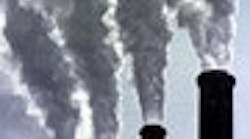An intriguing international spat over transboundary emissions is emerging between the Czech Republic and Micronesia, the region made up of hundreds of small islands lying thousands of miles away in the western Pacific Ocean. At the heart of the dispute is a plan by CEZ, Prague, the largest electricity producer in the Czech Republic, to refurbish its Prunerov II coal-fired power plant in Northern Bohemia.
The issue surfaced on January 4, when Deputy Minister Karel Blaha at the Czech Ministry of the Environment, Prague, received a letter from Andrew Yatilman, director of the Office of Environment & Emergency Planning on behalf of the Federated States of Micronesia. In it, Yatilman provides Micronesian inputs for consideration in accordance with the Czech Environmental Impact Assessment (EIA) Act.
The islands generally agree with the Prunerov II plan, but say that the EIA fails to assess all potential impacts and possible alternatives to minimize adverse impacts of such a modernization.
It goes on to "highly recommend" that the Czech Ministry of the Environment issue a negative final statement on the EIA carried out by CEZ and extend the process to include sufficient assessments of alternatives.
In particular, Micronesian states are concerned that proposed refurbishments won't deliver Best Available Technology (BAT) as required by both Czech and EU legislation — meaning a 42% minimum net energy efficiency. CEZ, they say, will only achieve 38%, resulting in an extra 9 million tons of carbon dioxide emissions over the plant's 25-year life. This, in turn, could contribute to global warming, raising sea levels and possibly submerging some of Micronesia's land.
"Although we are aware that greenhouse gases emissions produced solely by the Prunerov II power plant will not directly cause sea-level rise, change weather patterns and increase storms, there are approximately only 5,000 such power plants which contribute to global carbon dioxide emissions. Therefore every single power plant clearly plays an important role and warrants a transboundary impact assessment," concludes Yatilman.
Greenpeace Czech Republic, Prague, says that Prunerov is the 18th largest single source of carbon dioxide emissions in Europe, with 10 million tons of total annual emissions. This, it says, represents more than 40 times the annual emissions of the entire Micronesian Federation.
[pullquote]In a statement, the organization says that CEZ has violated regulations and ignored concerns raised by communities near the plant and the Ministry of Environment: "By demanding a transboundary EIA, the Government of Micronesia hopes to determine what impact the increase of emissions from the extended operation of the plant will have on the climate and on small Pacific island states."
Greenpeace also points out that this is the first time that current or future climate victims could legally influence a foreign industry by arguing that it endangers them due to greenhouse gas emissions.
CEZ, however, has come out fighting, criticizing non-governmental organizations that object to the planned Prunerov II refurbishment "with their half-truths or untruths." It says that its planned enhancements will use the latest technologies to tackle the sulfur, nitrogen and fly-ash that affect the quality of life in Northern Bohemia.
"The condition for use of the best available technology on the part of CEZ is definitely met. The problem is on the part of those who misinterpret the meaning and function of the best available technology and the BAT reference (BREF) documents describing these technologies."
That the company's preferred solution is said by some to threaten both health and the environment in the Czech Republic is dismissed as "fully untrue and CEZ strongly protests against it".
It also dismisses opponents' suggestions about using supercritical technology — the current BAT — because the existing plant burns local lignite coal. The higher grade coal demanded by supercritical units would have to be imported, with cost and emissions implications. CEZ estimates that emissions of carbon dioxide and other pollutants could rise by 30% or more if this route was adopted.
The latest twist in the tale is that the Czech government is to carry out an independent transboundary EIA. However, a government spokeswoman told U.K. magazine The Chemical Engineer on February 3, that this action wasn't influenced by Micronesia's challenge and would almost certainly have happened anyway. Rather, it was spurred on by EIA failure to give the Ministry the solid answers it was looking for, she said.
Seán Ottewell is Chemical Processing's Editor at Large. You can e-mail him at [email protected].

